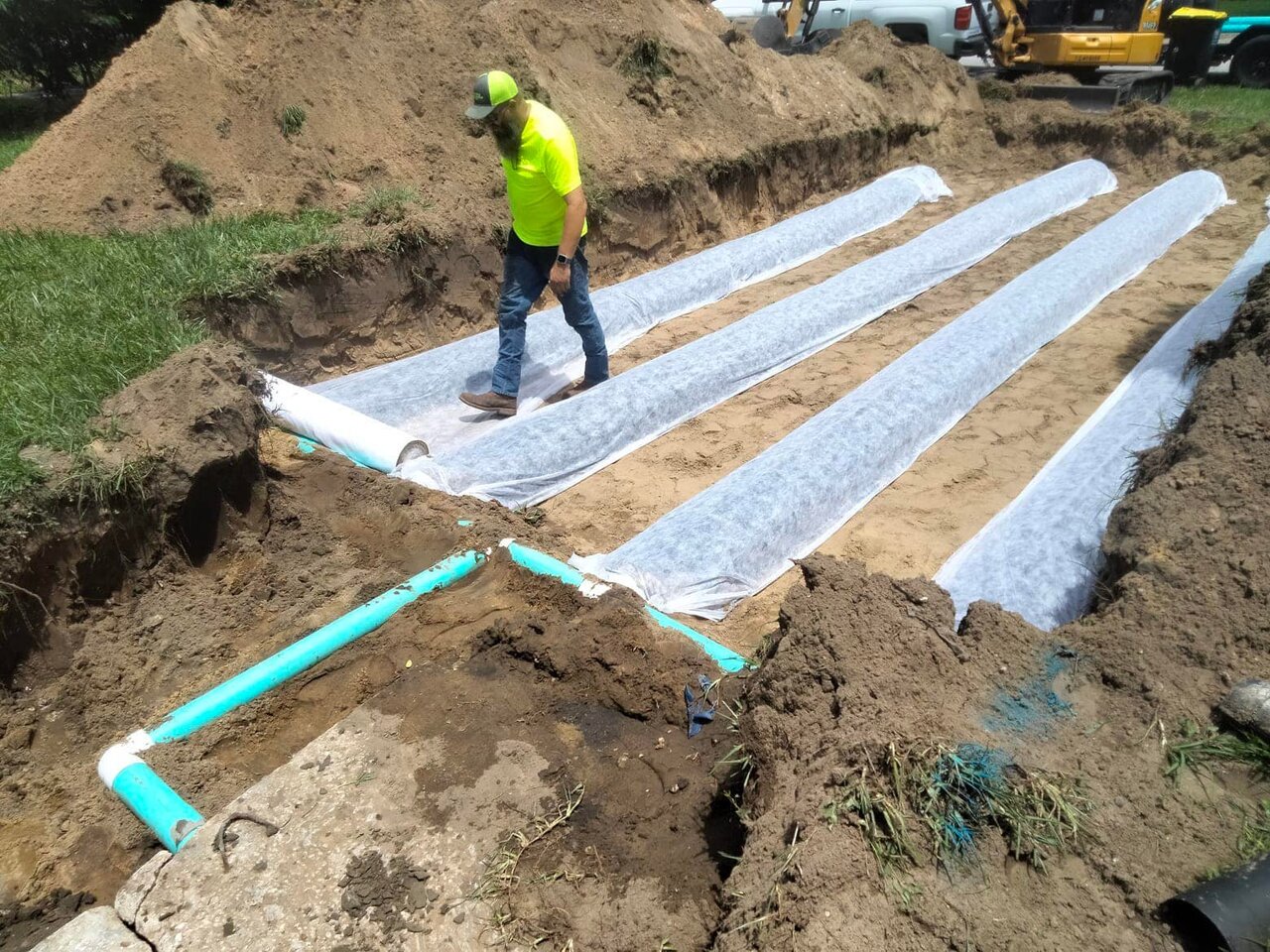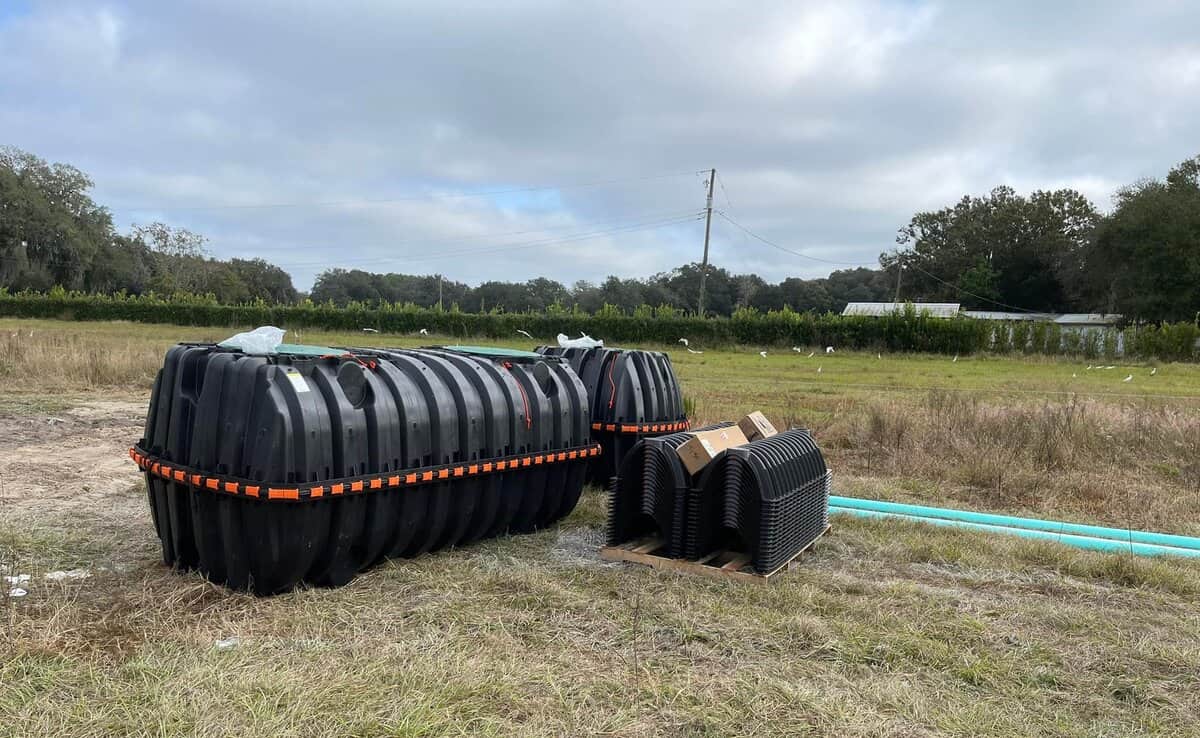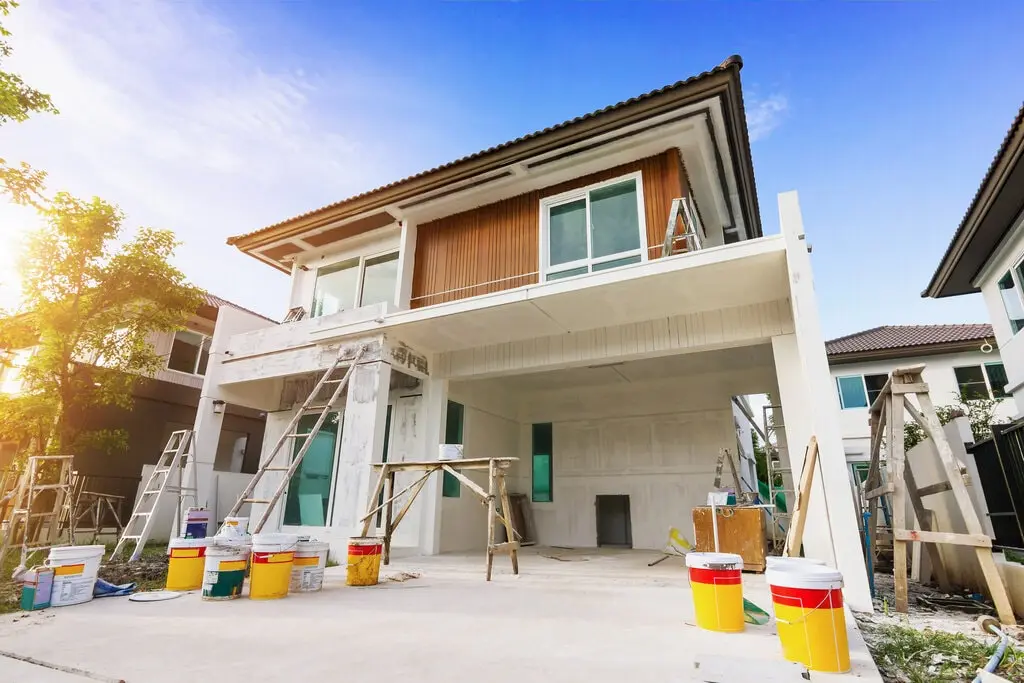The drain field (alternatively known as a leach field) is one of the main components of a home’s septic system. It is the final step in the process of treating the wastewater from the home, making the water safe to reenter the environment and use again.
How Does a Drainfield Work?
A septic system comprises several interconnected components and processes.
- First, the wastewater from the home runs out through one drainage pipe into a septic tank, which is a watertight container that is buried outside.
- Once in the septic tank, the wastewater is held long enough to allow solids to settle on the bottom, forming sludge. Oil and grease float to the top, leaving scum. The wastewater that forms the middle layer is called effluent.
- The effluent exits the tank through pipes into the drainfield, where it percolates through the soil. This process helps to remove harmful bacteria, viruses, and nutrients, rendering the wastewater safe.
According to the US Environmental Protection Agency, “The drainfield is a shallow, covered, excavation made in unsaturated soil. Pretreated wastewater is discharged through piping onto porous surfaces that allow wastewater to filter though (sic) the soil. The soil accepts, treats, and disperses wastewater as it percolates through the soil, ultimately discharging to groundwater.”
Drainfields are developed for each installation based on the considerations used in septic system design and an evaluation of the soil and ground conditions. Some drainfields use gravel to filter the wastewater, while other systems use sand or a different type of soil. Engineered septic systems may be used when soil or ground water conditions are not conducive to a standard drainfield, or if the drainfield is situated above the level of the home.
Installation, maintenance, and repair of a drainfield is dependent upon the type and size of the drainfield.
Signs of Drainfield Problems
Problems with a septic drain field are not always obvious. Homeowners should investigate further and contact a septic professional if they notice any of these signs:
- Toilets seem to be slow or sluggish when flushed
- Tubs, showers, and sinks drain slowly
- Puddles or damp soil above the septic tank or the septic tank drainfield not caused by rain or irrigation
- Excessive growth or greening of vegetation near the drainfield or septic tank
- Septic pump alarms or high water alert systems go off
- Strong odors outdoors
- Noises coming from the septic line
- Sewage backing up into the home
Any of these signs suggest that there could be a problem with the septic leach field, septic tank, or septic pipes. While it can be tempting to ignore the issue or postpone addressing it, doing so can cause bigger problems down the road. The cost to replace a septic tank and drainfield is obviously much greater than drain field repair, so acting promptly can actually be the most cost-effective thing to do.
Additionally, it is important to remember that untreated septic system issues can be dangerous to not only homeowners and immediate neighbors, but to the nearby water supply.

Causes of Drainfield Problems
Drainfield issues can be caused by many things, including:
- A poorly designed septic system
- Age of the septic system
- Parking or driving on the drainfield
- Tree or plant roots
- Overloading the septic system with too much wastewater
- Soil issues
- Lack of regular septic system maintenance
Drainfield Problem Solutions
When a septic tank drainfield is having problems, an experienced septic professional can do an inspection to assess what needs to be done and recommend appropriate action. Here are some of the solutions that might be used to get the septic system functioning properly:
Septic tank pumping and cleaning can remove harmful sludge and black slime from the septic tank and drainfield.
Cutting and killing roots that are impeding the system’s effectiveness might be necessary if large trees or plants have become invasive.
Soil fracturing can sometimes be used when soil has become compacted due to driving or parking on the drainfield. This creates a pathway for more oxygen to reach the seepage bed.
Bioremediation may be used when non-biodegradable solids like cigarette butts or feminine hygiene products have been flushed into the system. Removing these clogs and buildup can help restore the septic system to proper functioning.
Enzyme additives can be used when excess grease that has entered the system hardens, which prevents oxygen from entering the pipes. The additive can help break down the grease.
Septic system replacement may be necessary if the system is old, poorly designed or installed, or if the issues cannot be resolved any other way.
Avoiding Drainfield Problems
The best way to deal with drainfield problems is to avoid having them in the first place. While some issues are beyond anyone’s control, homeowners can take steps to minimize the likelihood of having issues with their drainfield.

- Never park or drive over any part of the septic system, especially the septic tank, drainfield pipe, or the leach field.
- Do not flush harsh chemicals like paint thinner or gasoline.
- Do not flush prescription or over the counter medications.
- Remember that the septic system is designed to process only toilet paper and human waste. Avoid disposing of items like wipes, diapers, cigarette butts, feminine hygiene products, condoms, or other non-biodegradable items.
- Do not plant trees or large plants close to the drainfield or the septic tank.
- Do not flush fats, oils, or grease.
Septic and Drainfield Services in and Near Lakeland
If your drainfield is showing signs of trouble, contact Septic and Drainfield Depot for a free estimate. Our experienced septic professionals can assess your issues and provide recommendations for getting your septic system back to its proper functioning.
In addition to drainfield services (drainfield installation, repair, and inspection), we offer:
- Residential and commercial septic pumping
- Septic tank installation, repair, and inspection
- Lift station installation and maintenance
We can help you obtain financing for your septic system without tapping into your home’s equity with affordable monthly payments.
As one of Lakeland and central Florida’s top septic contractors, Septic and Drainfield Depot is committed to upholding our reputation for quality workmanship and customer service.







